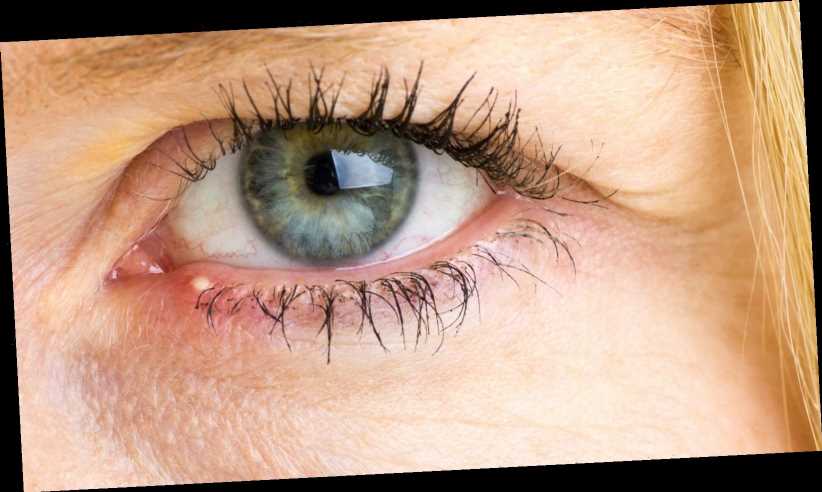
Dry eyelids are a condition that can cause the thin-skinned lids of one’s peepers to become flaky, red, or itchy. This delicate area can become irritated for many reasons, ranging from environmental conditions to an underlying health issue or even the overuse of a particular product.
According to Self, dry eyelids could be a symptom of several common skin conditions that can cause the area to experience sensitivity and pain. Dr. Joshua Zeichner, Director of Cosmetic and Clinical Research in the Department of Dermatology at Mount Sinai Hospital, told Self this irritation could be “caused by a disruption of the outer skin layer, loss of hydration, and inflammation.” The condition can also result from makeup or creams that may be too harsh for the sensitive eyelid area. Ingredients in these products can cause a chemical reaction in the body and bring on these painful symptoms.
So what exactly does it mean when your eyelids are dry and what should you do about it? Here’s a breakdown of this all-too-common condition.
The skin of the eyelid is sensitive for this reason

The eyelid is a thin layer of skin that covers and protects the eye. It contains a row of eyelashes that help protect the eye from dust, particles, and sweat. According to Very Well Health, the eyelid uses a squeezing mechanism to push tears over the area and maintain moisture with each blink. Although your eyelids constantly perform this essential task to keep your eyes functioning correctly, this area is also one of the body’s most sensitive areas and can become easily inflamed.
The skin surrounding the eye contains many small interior vessels that allow blood to flow and maintain optimum eye health. This delicate area is more prone to skin conditions than most other parts of the body, and irritation can be quite bothersome. Dermatologist Tiffany Jow Libby told Women’s Health magazine that eyelid skin is 80% thinner than skin on the rest of the body.
The causes of dry eyelids may surprise you
There are many reasons why the lids of the eyes can become inflamed or irritated. According to Optical Express, culprits may include low humidity, aging, and exposure to irritants. Other factors for eyelid irritation can include eczema and contact dermatitis.
According to the Mayo Clinic, eczema is a variation in a person’s genes that can affect the skin’s ability to protect itself from environmental factors, irritants, and allergens. The condition commonly creates the appearance of scaly skin on a person’s arms, legs, and neck, but eczema can also be a reason why eyelids suddenly become painful to the touch.
A skin condition called psoriasis may also be a contributing factor to dry eyelids, reports Medical News Today. Psoriasis occurs when skin cells grow much faster than they can be shed, causing them to pile on top of one another. This layering of dead skin cells can cause itching, burning, and painful sensations on the eyelids.
Dermatitis is yet another potential culprit for dry eyelids. This painful condition results from the skin’s exposure to an ingredient that reacts with the body’s chemical makeup. Irritating ingredients are sometimes found in commonly used products such as shampoos, styling products, face washes, moisturizers, makeup, and sunscreen, per Healthline.
Eyelid irritants may be hiding in common products
The eyelids are one of the first places a reaction may occur on the face. Self spoke to Dr. Amy Kassouf, a dermatologist at the Cleveland Clinic, to find out why a person’s eyelids are so easily affected. Kassouf noted that not only do airborne allergens in the environment react with the eyelids, but people often unknowingly rub their eyes after touching items. Allergens can be easily transferred in this way to the skin of the eyelids after handling common materials, such as money, nail polish, and makeup.
To maintain good eye health, Kassouf recommends keeping one’s beauty routine simple. If you’re experiencing dry eyelid symptoms, try to keep the area clean and dry and avoid makeup and creams. Use minimal moisturizer around the irritated area until the skin returns to its normal state. Reintroducing one product at a time can help identify the source that may have caused the undesired reaction.
Try these strategies to prevent dry eyelids
Dermatologist Tiffany Jow Libby told Women’s Health magazine that cooler weather can also contribute to dry eyelids. It’s the same concept as suffering from chapped lips. “During the fall and winter months, the weather can cause skin to be stripped of its oils which impairs the skin’s natural moisture barrier and leads to dry, itchy skin on the body,” Libby said. Scaling and crusting around the eyelids can occur and create flakes that stick to the eyelashes like dandruff.
According to WebMD, lifestyle changes could help alleviate or eliminate the problem. Shorter showers or baths can help with those that struggle with a dry skin condition. Using warm, rather than hot, water may help because higher temperature water tends to draw moisture from the skin. The use of gentle, hypoallergenic soaps can also assist in the healing of the delicate eye area. A humidifier could add much-needed moisture to your living space.
If you’ve tried unsuccessfully to pinpoint the causes of your dry eyelids, or if the situation worsens, reach out to a doctor. Healthline reports that a doctor may recommend an over-the-counter or prescription topical corticosteroid to treat the afflicted area if dermatitis is suspected. Your doctor may also suggest antihistamines to help with sleeping or antibiotics for associated infections.
Keep an eye on your symptoms, and you’ll soon see your way out of the dry eyelid conundrum.
Source: Read Full Article



